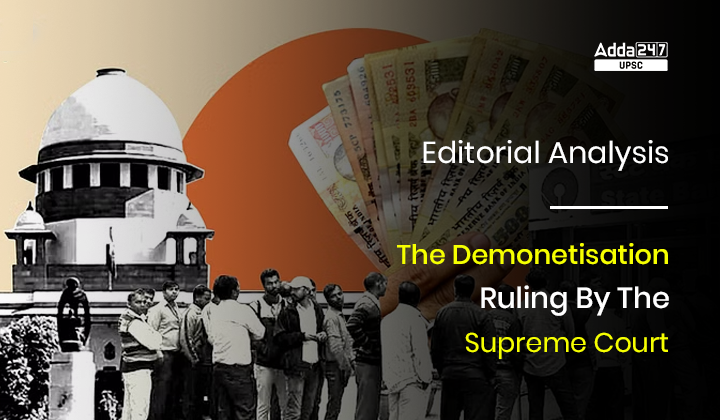Table of Contents
The Demonetization Ruling By The Supreme Court: In Its recent 4:1 Majority Verdict, The Supreme Court Of India Upheld the Central Government’s Decision(taken in 2016) To Demonetize Currency Notes Of Rs 500 and Rs 1,000 that were then in circulation.
This Topic Of Today’s The Hindu Editorial Covers GS Paper 2: Government Policies and Interventions for Development in various sectors and Issues arising out of their Design and Implementation
What Is The Issue?
- On November 8, 2016, the PM of India announced that the Rs 500 And Rs 2000 notes would no more be legal tender, with immediate effect.
- The Reason was to curb fake currency notes and reduce black money stored as cash.
- Though supported by many, 58 petitions have been filed in the SC challenging various aspects.
- But Now, the Supreme Court on 02-01-2023 upheld the decision of the Central government taken in 2016 to demonetise the currency notes of Rs 500 and Rs 1000 denominations.
The EWS Judgement! | The Hindu Editorial Analysis for UPSC
What Was The Legal Basis Of Filing Petition Against Demonetization?
- The 58 petitioners accused that Section 26(2) of RBI Act, 1934, was not followed, as according to this act, only after the recommendation of the RBI’s Central Board, the Central Government may, by notification in the Gazette of India, declare that any series of bank notes of any denomination shall cease to be legal tender.
- The court was to consider whether the recommendation for the policy came from the government or the RBI.
What Are The Key Points Of The Supreme Court’s Demonetization Ruling?
With a 4:1 majority, a five-judge Constitution bench of the S.C. dismissed a batch of petitions challenging the decision saying that the demonetization decision, being the Executive’s economic policy, cannot be reversed.
Supreme Court says there was consultation between the Centre and the RBI before demonetisation. The Apex Court also held that demonetisation was not hit by the doctrine of proportionality. Key Points:
- The S.C. says that the Centre’s notification was valid and satisfied the test of proportionality – a reasonable nexus between the objectives and the means to achieve the objectives.
- From the record, it appears that there was a consultative process between the central government and RBI for over 6 months before the decision was taken.
- The Decision-making process cannot be faulted merely because the proposal emanated from the centre (as the government and RBI are not in ‘isolated boxes’) and the court cannot replace the wisdom of the executive with its wisdom.
- The action taken by the Central Government has been validated by the Specified Bank Notes (Cessation of liabilities) Act, 2017, which prohibited and penalised the holding or transferring or receiving of demonetised currency.
Justice B.V. Nagarathna’s dissent
- She declared that the 2016 demonetisation exercise was unlawful, since the proposal was initiated by the central government and not by the central board of the Reserve Bank of India (RBI).
- She also said there was no independent application of mind by the RBI.
- She also said fundamental rights under Articles 19 and 21 of the Constitution cannot be enforced against persons other than the State or its instrumentalities. However, they may be the basis for seeking common law remedies.
- She also put importance of a proper legal framework to define the acts or omissions which would amount to constitutional torts to seek remedy by the aggrieved persons following a vitriolic or disparaging statements by public functionaries.
What Is doctrine of proportionality?
- Proportionality means that the administrative action should not be more drastic than it ought to be for obtaining the desired result.
- The Supreme Court’s majority decision in demonetization case has brushed aside arguments based on proportionality, holding that demonetisation survives every test for proportionality: there was a legitimate purpose (unearthing fake currency and hoarded wealth and combating terror funding), there was a nexus between the action and the objectives, and the court did not have the expertise to suggest a less intrusive way of achieving these objectives.
The Hindu Editorial Analysis: NPAs & Bad Loans Are No More A Headache
You may also find these Useful:
(Recent Editorial Analysis by our team at Adda247)



 TSPSC Group 1 Question Paper 2024, Downl...
TSPSC Group 1 Question Paper 2024, Downl...
 TSPSC Group 1 Answer key 2024 Out, Downl...
TSPSC Group 1 Answer key 2024 Out, Downl...
 UPSC Prelims 2024 Question Paper, Downlo...
UPSC Prelims 2024 Question Paper, Downlo...





